Table of Contents
Diagnostic and Implants
The two main research areas listed below apply the classic engineering approach of modeling the auditory pathway in the spaces of frequency, time and level (to account for nonlinearity) to the validation and development of new diagnostic methods, particularly, but not only, to distortion product otoacoustic emissions (DPOAE) and the development of active acoustic implants that vibrate the hearing system.
Senior Investigator: Dr.-Ing. Ernst Dalhoff

Department of Otolaryngology, Head and Neck Surgery
Tübingen Hearing Research Centre
Elfriede-Aulhorn-Strasse 5
D-72076 Tübingen
Germany
Phone: +49(0)7071-29-88232
Ernst.Dalhoff@uni-tuebingen.de
Audiometry, DPOAE in humans
Clinical audiometry includes subjective (e.g. tone and speech audiometry) and objective methods (no patient intervention required): acoustic impedance measurements at the entrance to the hearing system (tympanometry, stapedial reflex audiometry), oto-acoustic emissions (TEOAE, DPOAE) and electro- physiological methods (ABR, ASSR). We currently focus on distortion product otoacoustic emissions (DPOAE), but include other methods for control or further development.
Very simply, the cochlea and the so-called cochlear amplifier can be viewed as the middle element of the hearing system. The cochlear amplifier is the stage that is most often affected first when a patient develops hearing loss. This typically affects the otoacoustic emissions (OAE) that are produced as a byproduct of a properly functioning amplifier. To measure OAE, you need a speaker and a microphone in the ear canal. So OAE are produced in the cochlea, but are also dependent on middle ear transmission.
DPOAEs are special because:
1) Nowadays in research one can reliably separate the primary source component and obtain a very robust frequency-specific measure, and
2) it now appears possible to separate the middle ear component, leading to a diagnosis specific to the cochlear condition.
Furthermore, through appropriate manipulations during the experiment, it appears possible to also measure neuronal activity up to the brainstem, as efferent fibers project back to the outer hair cells, leading to a measurable inhibitory adjustment of cochlear gain and DPOAE. Therefore, DPOAEs are ideal for differentially diagnosing pathologies along the entire pathway up to the brainstem.
Challenges and goals
The challenges are diverse. Any solution that attempts to go beyond what traditional hearing aids can offer today must first improve the audiological/sound quality problem. Current hearing aids have limitations depending on the application: With so-called open-fit hearing aids, the preferred and most comfortable configuration, the achievable gain at low frequencies is reduced. High-frequency amplification can also be inadequate or at least suboptimal - the typical cutoff frequency of effective stimulation is 5 kHz, which depends heavily on the exact type of hearing impairment. Even in the mid-band, despite tremendous improvements in the signal processing schemes of digital hearing aids over the past two decades, limited feedback margin can result in insufficient gain at certain frequencies and a concomitant degradation in signal quality.
For implantable solutions, there are additional challenges, for example, achieving the required miniaturization and volumetric energy density, but most importantly, developing a scheme that ultimately turns out to be implantable with stable results and not leading to immense/impractical surgical requirements.
Active acoustic implants
Currently, most hearing impairments cannot be cured but are rehabilitated through the prescription of a hearing aid. For severe to profound or total hearing loss, electrical stimulation of the auditory nerve with a cochlear implant is the remaining solution for rehabilitation. In the transition area between the indication areas of hearing aids and the cochlear implant, there is an area in which active acoustic implants can be the preferred rehabilitative option. Often referred to as “active middle ear implants”, these are partially or fully implantable and are usually attached to part of the ossicular chain or round fenestra membrane, where they stimulate directly by mechanically vibrating the structure to which they are attached. Even if conventional treatment is not successful for chronic middle ear pathologies, active middle ear implants can be the rehabilitative option that leads to the best audiological outcome.
In addition to applications with clear medical indications, however, the dream remains of an implant that replaces the hearing aid, but is as permanent and inconspicuous as a dental implant and offers superior sound quality and an optimal audiological result (where current hearing aids have potential for improvement).
In addition, solutions to the same problem without the need for permanent implantation are also conceivable, and the hearing contact lens may prove to be such a solution in the future.
Challenge and goals
The challenges are diverse. Any solution that attempts to go beyond what traditional hearing aids can offer today must first improve the audiological/sound quality problem. Current hearing aids have limitations depending on the application: With so-called open-fit hearing aids, the preferred and most comfortable configuration, the achievable gain at low frequencies is reduced. High-frequency amplification can also be inadequate or at least suboptimal - the typical cutoff frequency of effective stimulation is 5 kHz, which depends heavily on the exact type of hearing impairment. Even in the mid-band, despite tremendous improvements in the signal processing schemes of digital hearing aids over the past two decades, limited feedback margin can result in insufficient gain at certain frequencies and a concomitant degradation in signal quality.
For implantable solutions, there are additional challenges, for example, achieving the required miniaturization and volumetric energy density, but most importantly, developing a scheme that ultimately turns out to be implantable with stable results and not leading to immense/impractical surgical requirements.